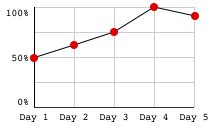In the field of nuclear physics, half-life refers to the amount of time required for radioactive substances to decay into half. In this lesson, we will work on word questions about exponential decay of radioactive substances.
exponential growth/decay:
: final amount
: initial amount
: growth/decay factor
half-time
triple
ten-fold
increase by 10%
decrease by 8%
: total time given
: every length of time
: final amount
: initial amount
: growth/decay factor
half-time
triple
ten-fold
increase by 10%
decrease by 8%
: total time given
: every length of time






